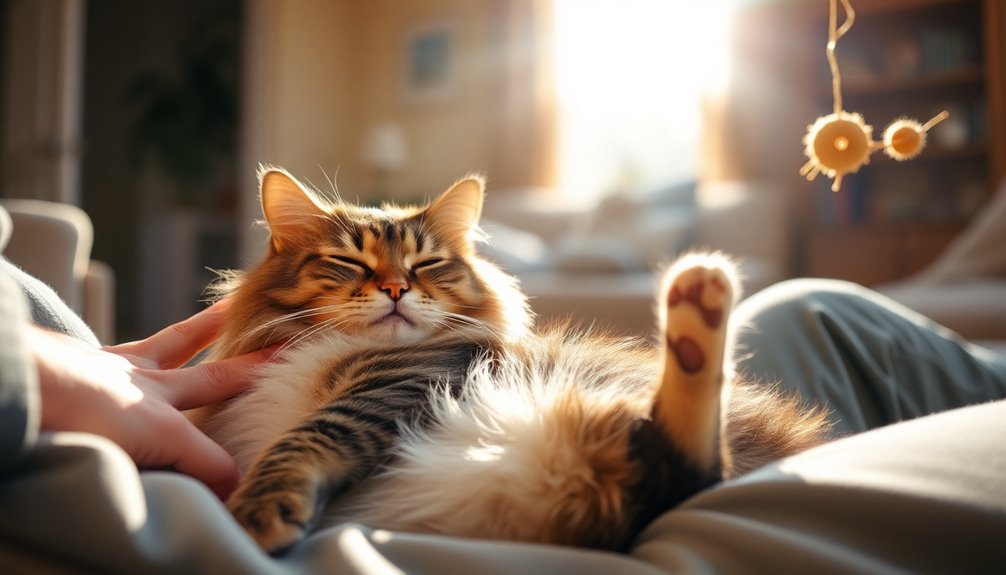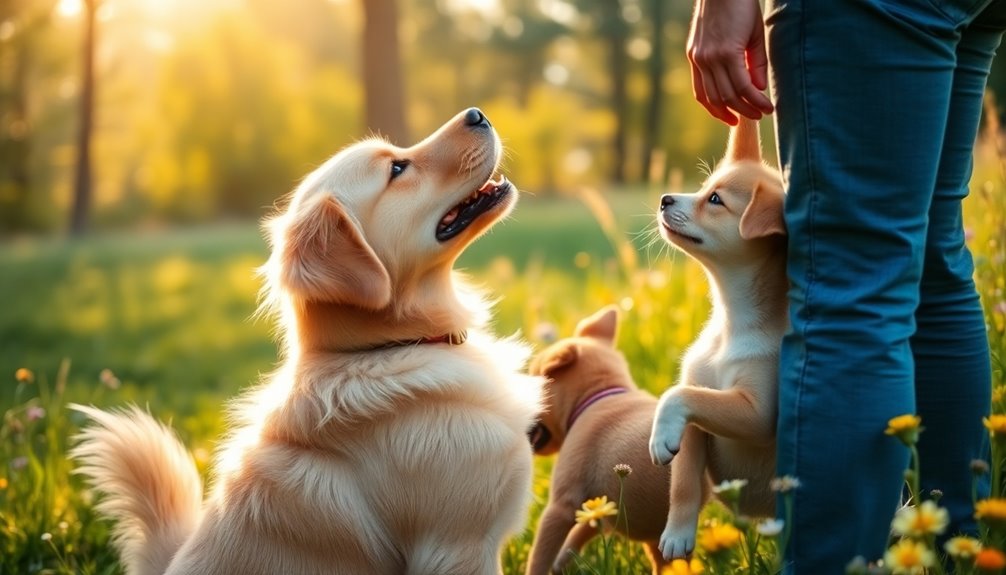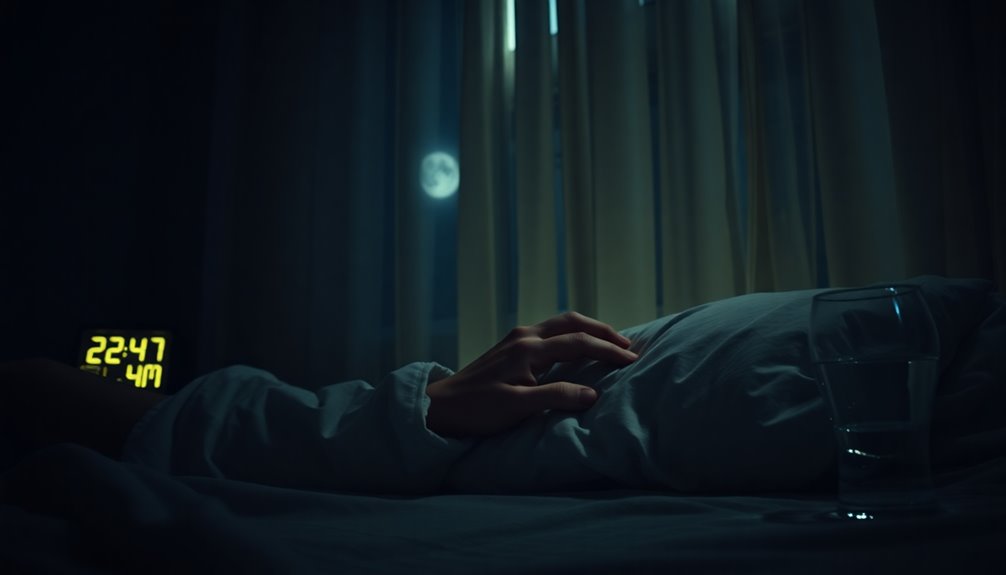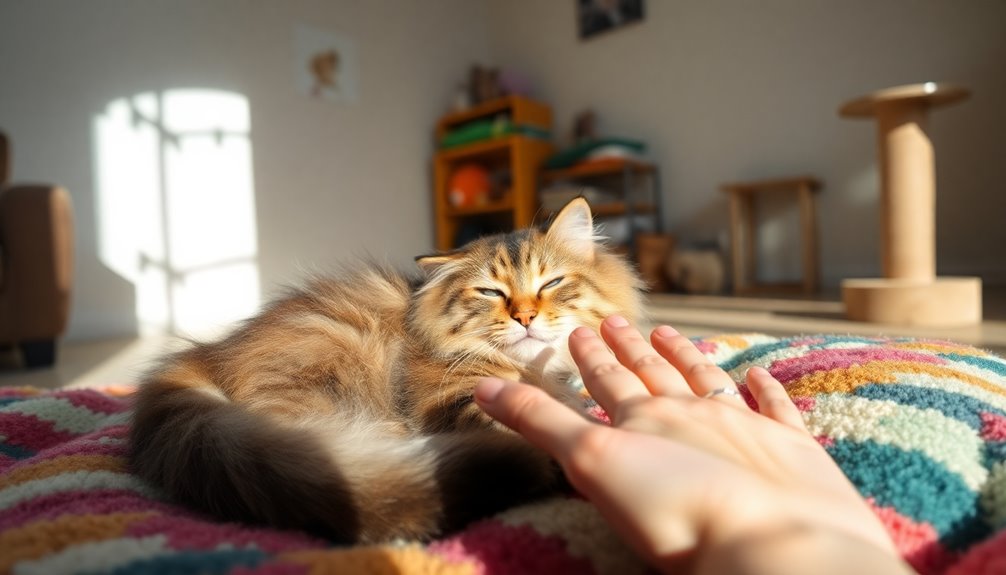Yes, cats do love their owners, often showing it through surprising behaviors. You might notice head-butting, purring, and slow blinking, all signs of affection. Cats communicate their feelings with soft meows and relaxed body language, indicating they feel safe with you. They may even bring you "gifts" like prey or toys, showcasing their love and sharing instincts. Cats also form strong attachments, similar to dogs, and thrive on routines that foster connection. These little actions reveal their emotional depth, hinting at a bond that runs deep. There's much more to explore about your feline friend's affectionate nature.
Key Takeaways
- Cats express affection through behaviors like head-butting, purring, and kneading, indicating their love and trust towards their owners.
- Unique communication methods, such as meowing and slow blinking, showcase emotional needs and strengthen bonds between cats and their humans.
- Cats display attachment behaviors, similar to dogs, emphasizing their strong emotional connections with their owners.
- Engaging in shared experiences, like playtime and grooming, fosters deeper connections and reinforces affectionate behaviors.
- Respecting a cat's need for space and maintaining a stable environment enhances their comfort and ability to express love.
Signs of Feline Affection
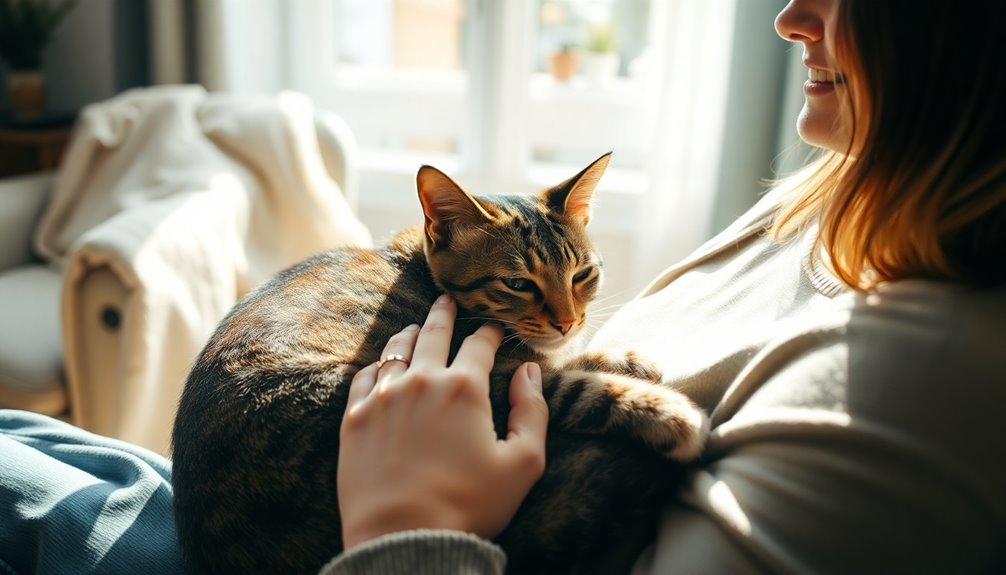
When you spend time with your cat, you might notice several signs of affection that reveal just how much they care.
Cats show affection in various ways, like head-butting and nuzzling, known as bunting. This behavior not only signifies trust but also marks their territory with your scent.
If your feline friend purrs and kneads, they're expressing contentment, mimicking the comforting actions of kittens with their mothers.
Slow blinking, or a kitty kiss, indicates safety and trust.
Physical proximity is another strong sign; when your cat sits on your lap or follows you, it shows they enjoy your company.
Finally, if they bring you a "gift," like prey, it reflects their instinctual gift-giving behavior, symbolizing love and trust.
Unique Communication Methods
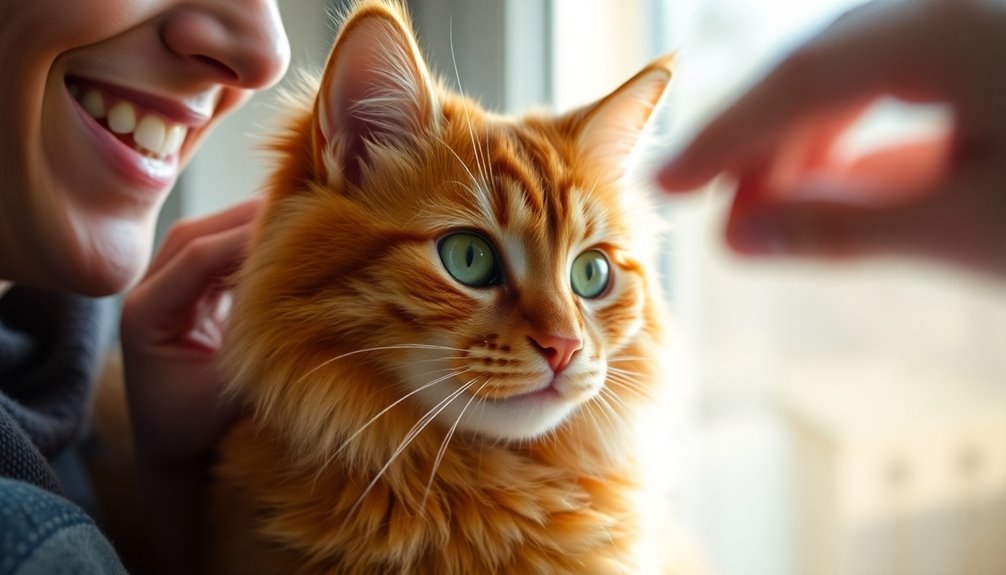
Cats have a fascinating way of communicating that goes beyond mere vocalizations. Their unique communication methods reveal how cats socialize and show affection toward you.
For instance, slow blinking, often referred to as "kitty kisses," signifies trust and safety in your relationship. While most people think meowing is for communication with other cats, it's primarily for you, with softer tones expressing emotional needs.
A high, curved tail indicates happiness, reflecting your cat's positive feelings. Purring not only shows contentment but also occurs when they feel secure around you.
Additionally, relaxed posture and gentle nuzzling are key cat behaviors that indicate they seek closeness and affection, making it clear that your bond is truly special.
Understanding Cat Behavior
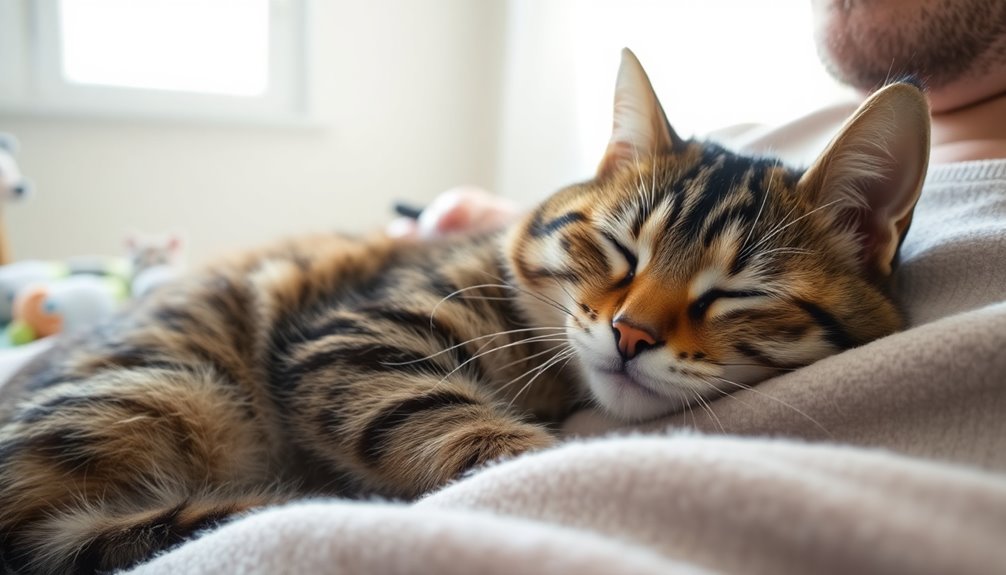
Understanding your cat's behavior can deepen the bond you share. Cats exhibit various behaviors that reflect their emotions and social connections. Recognizing these signs helps you appreciate their unique cat cognition and social behavior.
- Head-butting signals affection and trust.
- Purring can indicate comfort and contentment.
- Slow blinking shows that your cat feels secure with you.
- Tail positions reveal their mood and intentions.
Research shows that about 66% of cats demonstrate attachment behaviors, much like dogs, suggesting they're truly attached to people. Additionally, studies indicate that early exposure to STEM education can enhance cognitive development in animals, reflecting the importance of understanding behavior in all creatures.
Creating a Nurturing Environment

Creating a nurturing environment is essential for fostering a strong bond between you and your cat. When you provide a cozy sleeping area and scratching posts, you promote your cat's comfort and reduce stress, encouraging affectionate behavior.
Establishing a consistent routine for feeding and playtimes helps your cat feel secure, which is vital for their emotional well-being. Utilize positive reinforcement techniques, like treats and praise, to reward affectionate actions, enhancing their desire to engage with you.
Incorporating interactive toys and environmental enrichment keeps your cat mentally and physically stimulated, leading to increased playfulness.
Ultimately, a secure environment allows your cat to express their love through behaviors like head-butting, slow blinking, and purring, deepening your connection.
Strengthening Your Bond
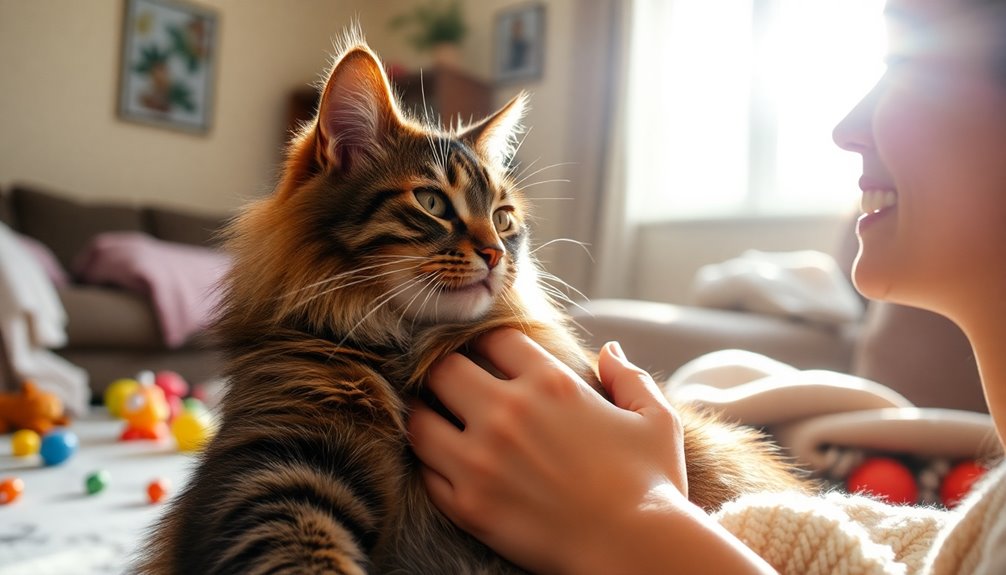
While you may think of bonding with your cat as simply spending time together, it actually involves a combination of activities that nurture your relationship. Engaging in interactive play stimulates their hunting instincts and fosters trust and affection, enhancing your bond.
Here are some effective ways to strengthen your connection:
- Create cozy sleeping areas and scratching posts for comfort.
- Recognize and respect your cat's unique preferences and boundaries.
- Schedule regular grooming sessions to provide comfort and reduce stress.
- Establish consistent routines for feeding and playtime to reinforce security.
Emotional Connections With Cats

Building a strong bond with your cat goes beyond physical closeness; it taps into the emotional connections that flourish between you.
Studies show that cats can form secure attachment bonds with their owners, exhibiting behaviors like proximity-seeking and distress when separated. Approximately 66% of cats demonstrate these secure attachment behaviors, indicating they experience emotional connections similar to those of children and their parents.
Cats recognize your voice and name, reinforcing their awareness of you as a companion. When you leave, their distress is evident, but it fades quickly upon your return.
Historical Context of Cats
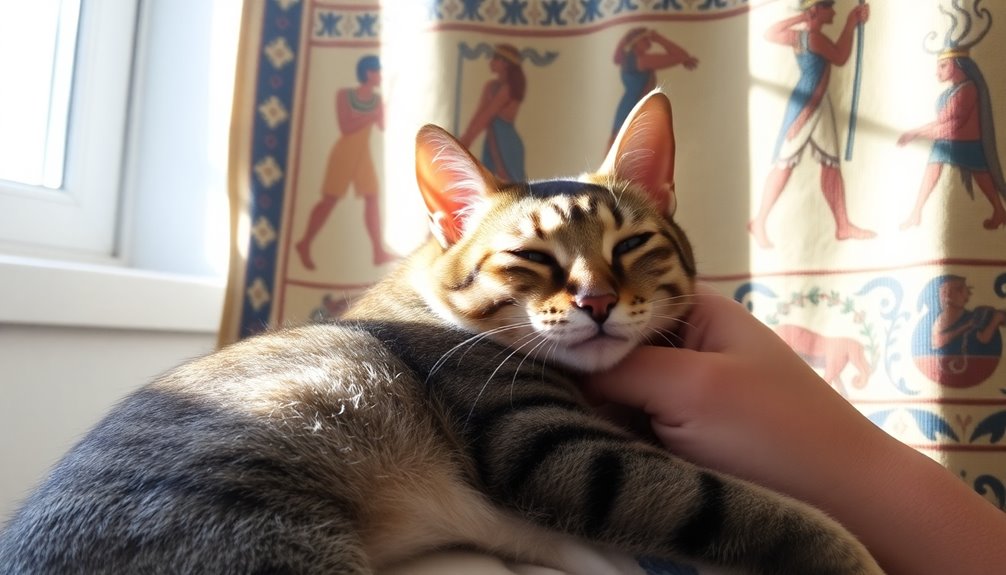
As humans began to cultivate the land around 12,000 years ago, they unknowingly set the stage for a unique partnership with cats.
These fascinating creatures thrived alongside us, providing pest control in return for food and shelter. Ancient Egyptians revered cats, seeing them as magical beings connected to their deities.
Over time, cats' self-sufficient behavior contrasted with the more affectionate nature of dogs.
- Cats have adapted to human environments while maintaining their unique social structures.
- Cultural perceptions of cats have shifted, influencing their roles in society.
- They've been celebrated for their independence throughout history.
- Today, we recognize cats for their companionship and emotional connections.
This long-standing relationship continues to evolve, highlighting the intricate bond between cats and humans.
Misinterpretations of Feline Affection
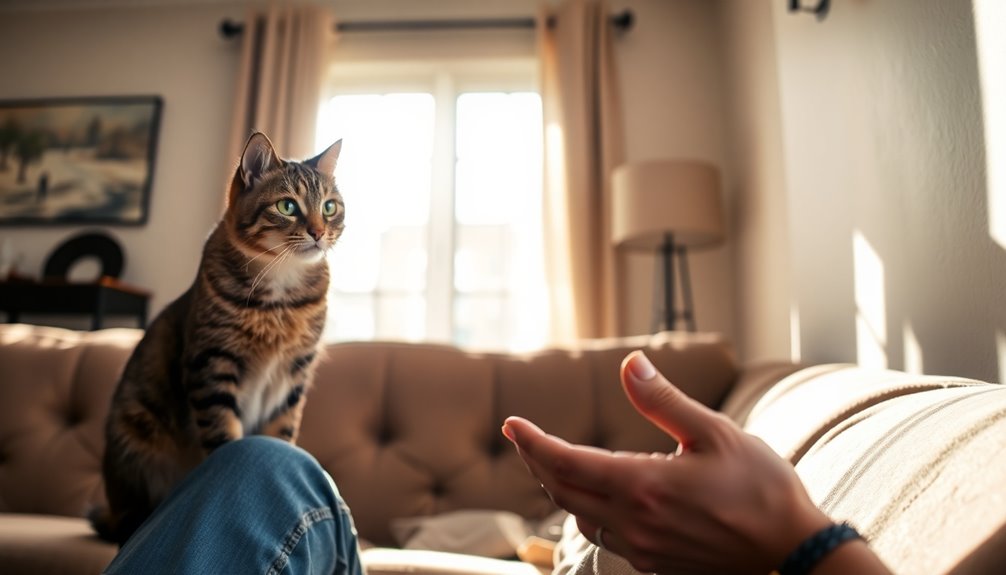
You might think your cat is aloof when they actually have their own unique ways of showing affection.
Understanding their signals, like purring and slow blinking, can change how you view your feline friend. Misconceptions about their emotional needs can lead to confusion, making it essential to recognize the depth of their feelings.
Understanding Cat Signals
Cats communicate their affection in various nuanced ways, but many owners misinterpret these signals. Understanding your cat's behaviors can deepen your bond and enhance your appreciation of their unique affection.
Here are a few key signals to watch for:
- Slow blinking: Often called a "kitty kiss," it's a sign of trust.
- Proximity: If your cat follows you around, they're expressing love, not aloofness.
- Purring: While usually a sign of contentment, be mindful of context—stress can trigger purring too.
- Head-butting: Known as bunting, this marks territory and shows affection.
Common Misconceptions About Affection
While many people think of cats as solitary creatures that don't need companionship, this misconception overlooks the complex emotional lives these animals lead.
Cats form deep emotional connections and express affection through subtle signals like purring, kneading, and even head-butting. Unlike dogs, they may not seek constant physical contact, but that doesn't mean they lack attachment.
Many owners misunderstand feline relationships and fail to recognize behaviors such as gift-giving, which signify trust and love. Additionally, cats can experience distress when separated from their owners, highlighting their need for companionship.
The Role of Playtime

Engaging in playtime is essential for nurturing the bond between you and your feline friend, as it taps into their natural hunting instincts.
Regular play sessions greatly enhance your cat's emotional well-being, reducing stress and fostering a secure attachment. In fact, studies show that about 50% of cats prefer human interaction during play over food, highlighting the social value of these activities.
- Strengthens trust and affection
- Stimulates physical and mental activity
- Reinforces positive behaviors through positive reinforcement
- Creates shared experiences that deepen your connection
Recognizing Your Cat's Love

You mightn't realize it, but your cat has its own special ways of showing love.
From slow blinks to head-butts, these unique behaviors reveal their affection and trust.
Signs of Affection
Cats have their unique ways of showing affection, and recognizing these signs can deepen the bond between you and your feline friend.
Pay attention to your cat's behavior and facial expressions, which reveal their inner lives. Here are some common signs of affection from domestic cats:
- Bunting: Head-butting and nuzzling signify trust and territory marking.
- Purring and Kneading: These indicate contentment, mimicking kitten behavior.
- Slow Blinking: A "kitty kiss" shows safety and trust; try reciprocating it!
- Gift-Giving: Bringing you prey or toys reflects love and sharing instincts.
Unique Communication Methods
While many people might think that cats are aloof, they actually have a rich array of communication methods to express their love and affection.
One of the most unique communication methods is slow blinking, often called "kitty kisses," which signifies trust when you blink back. Soft meows can reveal your cat's emotional needs, showcasing their desire for connection.
Pay attention to their tail position; a high, curved tail indicates happiness and security in your presence. Additionally, your cat's affectionate behavior is evident when they sit on your lap or follow you around, demonstrating their need for physical proximity.
Finally, purring reflects their contentment and comfort, reinforcing the bond you share.
Frequently Asked Questions
Do Cats Actually Love Their Owners?
Do cats actually love their owners? You might be surprised to learn that many cats form strong attachment bonds with you, showing signs of affection and trust.
They often express their feelings through purring, slow blinking, and wanting to be close to you. When your cat seeks your company or engages in play, it's a clear indication of their emotional connection.
How Can You Tell if a Cat Is Bonded to You?
You can tell if a cat is bonded to you through their behaviors.
If they head-butt or nuzzle you, they're showing trust and affection. When your cat gives you slow blinks, it's like a kitty kiss, indicating they feel safe.
Purring and kneading are signs of contentment, too.
If they follow you around or prefer to sit near you, it's clear they enjoy your company and value your presence.
How to Tell if You Are Your Cat's Favorite Person?
To tell if you're your cat's favorite person, pay attention to their behaviors.
If they often sit on your lap or follow you around, it's a good sign. Engaging in playtime strengthens your bond, too.
Look for slow blinks from them; it's like a kitty kiss. If they bring you toys or meow softly at you, those are clear indicators that they hold you in high regard.
What Does It Mean When a Cat Sits With Its Back to You?
Ever wondered what it means when your cat sits with its back to you?
It's more than just a quirky habit. This posture shows that your feline feels safe and trusts you completely. By turning away, they're letting their guard down, signaling comfort in your presence.
It's a subtle yet powerful sign of affection, indicating they value your companionship while still maintaining their independence. You're definitely part of their secure world!
Conclusion
In the end, cats do love their owners, even if they show it in quirky ways. Remember, "actions speak louder than words." By paying attention to their unique communication and creating a nurturing environment, you can strengthen your bond. Embrace their playful antics and understand their behavior to recognize the love they're sharing. With patience and care, you'll discover just how deep that feline affection truly runs. Your cat's love is all around you—if you know where to look!
